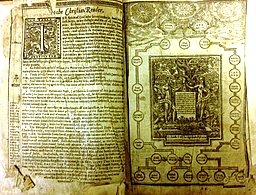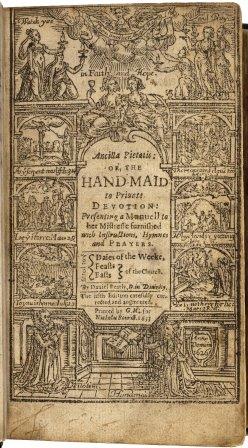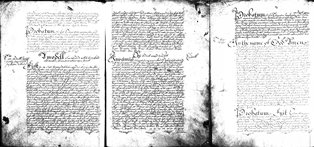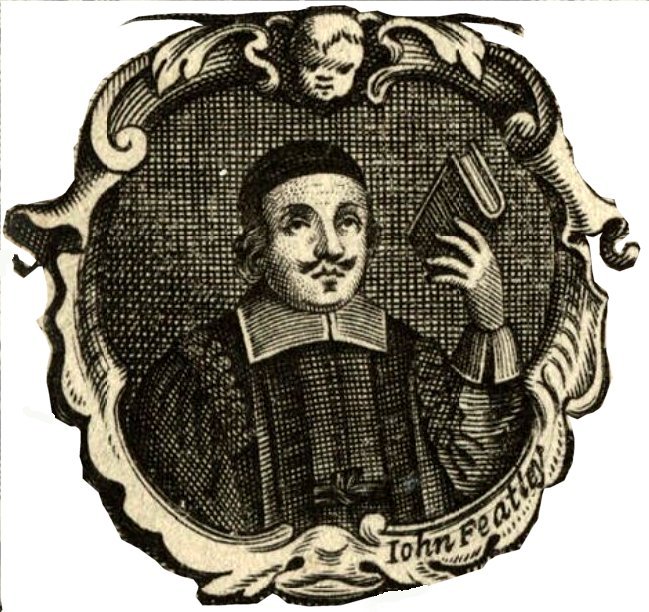|
Daniel Featley was Rector of St Torney's Church in North Hill from 1613 for about four years. His time at North Hill was short and his direct impact upon the parish was that he was instrumental in bringing the Darley family to North Hill. The Darley family provided the rectors of St Torney's from 1619 to 1708.
Daniel developed Puritan leanings and his radical and plain-spoken preaching did not endear him to everybody, particularly those with power and influence in the Church. His influence upon Calvinistic and anti-Catholic attitudes in Britain was significant and is well documented. He is shown here in a later engraving by William Marshall.
This page attempts to provide an overview of the fascinating life of Daniel Featley including those events in his life that intersect with North Hill.
Daniel's father was John Fairclough who migrated from Lancashire to Charlton-upon-Otmoor in Oxfordshire. He married Marian Thrift, about 1580. They had 5 children there: John, Daniel, William, Margaret and Anne, all of whom were baptised with the surname of Featley.
 Whilst the family surname was Fairclough, The Dictionary of National Biography records that Featley was a 'vulgarised spelling'. It also asserts that Daniel was the first to adopt the surname of Featley but this had been used by an earlier generation. The engraving, made many years after the name Featley had been first used, shows a coat of arms in the top left corner and these are the arms of the Fairclough family. Another divine with potential connections is Samuel Fairclough, a contemporary of Daniel's, whose image is in the National Portrait Gallery and whose portrait also shows the Fairclough arms. One of descendants of the family, Colin Featley (cefeatley_at_aol.co.uk), has been researching the family and discovered that all the Featleys that attended university, including Daniel, did so under the name Fairclough. For the purposes of this narrative we shall persist with the surname of Featley by which the family were most well known and as they are known today. Whilst the family surname was Fairclough, The Dictionary of National Biography records that Featley was a 'vulgarised spelling'. It also asserts that Daniel was the first to adopt the surname of Featley but this had been used by an earlier generation. The engraving, made many years after the name Featley had been first used, shows a coat of arms in the top left corner and these are the arms of the Fairclough family. Another divine with potential connections is Samuel Fairclough, a contemporary of Daniel's, whose image is in the National Portrait Gallery and whose portrait also shows the Fairclough arms. One of descendants of the family, Colin Featley (cefeatley_at_aol.co.uk), has been researching the family and discovered that all the Featleys that attended university, including Daniel, did so under the name Fairclough. For the purposes of this narrative we shall persist with the surname of Featley by which the family were most well known and as they are known today.
Daniel's father worked at Oxford University and, through his connections, Daniel was educated there. Typically a classical education at this time was formed from the seven liberal arts of Grammar, Logic, Rhetoric, Arithmetic, Geometry, Music and Astronomy. Whilst education was important for its own sake, the learning strongly supported religious thinking and Daniel was heavily influenced during his time as a student by some of the leading thinkers of the day, such as John Rainolds. Students with a Bachelor's degree, but studying for a higher qualification, would teach younger students. Whilst Daniel was teaching at Oxford one of his students was Ezekiel Arscott of Tetcott in Devon, just fifteen miles north of North Hill.
 During his time at Oxford Daniel quickly advanced within the Church and was the youngest translator of the Authorised Version of The King James Bible, a page from which is shown, right (*attribution). He was appointed in 1611 to be the chaplain to the English ambassador in Paris, Sir Thomas Edmonds, where his understanding of politics and diplomacy made him a strategic asset. In 1613, immediately following his term as Edmonds’s chaplain, Daniel returned to Oxford for a short stint to take up his bachelors' degree in divinity, but promised Edmonds that he would return to France to continue working in Edmonds’ service. Despite leaving, Daniel sought to preserve his valuable connection with Edmonds, even while pursuing a more attractive option, the incumbency of St Torney's in North Hill. During his time at Oxford Daniel quickly advanced within the Church and was the youngest translator of the Authorised Version of The King James Bible, a page from which is shown, right (*attribution). He was appointed in 1611 to be the chaplain to the English ambassador in Paris, Sir Thomas Edmonds, where his understanding of politics and diplomacy made him a strategic asset. In 1613, immediately following his term as Edmonds’s chaplain, Daniel returned to Oxford for a short stint to take up his bachelors' degree in divinity, but promised Edmonds that he would return to France to continue working in Edmonds’ service. Despite leaving, Daniel sought to preserve his valuable connection with Edmonds, even while pursuing a more attractive option, the incumbency of St Torney's in North Hill.
Ezekiel Arscott was aware of Daniel's rising profile and held him in high esteem. The Arscott family held the advowson of North Hill at the time and Ezekiel knew, therefore, of the vacancy for the Rector of St Torney's, following the death or departure of the Reverend Henry Phillips in 1613. Ezekiel recommended Daniel to his family for the position and he was duly appointed.
Daniel wrote to Edmonds on 10 August 1613 from London, expressing that although "I desired nothing more to performe my promise to your Lordship by rendring my self to your honours service", his circumstances had changed. He had been offered and accepted "a benefice in Mr [Ezekiel] Arscots gifte worth 7 score and ten pounds per annum"’ at North Hill in Cornwall. He claimed that he planned to stay briefly in Cornwall, find "a painfull preacher" to take his place, and then "returne into France to finish my course with your Lordship".
Daniel's time as Rector of North Hill lasted about four years. In February 1618 Daniel was invited to take up the living at St Mary, Lambeth; this is the church adjoining Lambeth Palace, the residence of the Archbishop of Canterbury. At the time the Archbishop was George Abbot, a Calvinist whose views were shared by Daniel. Daniel's last act that had a direct impact upon North Hill was to recommend his new brother in law to replace him at North Hill. Daniel had officiated at the marriage of his sister Ann to the Reverend John Darley on 9th June 1619 at St Mary, Lambeth. Following the marriage John Darley and his bride set off for Cornwall to begin a dynasty that was to last for nine decades in North Hill.
In the early 1620s Daniel married a Mrs Joyce Holloway. There was no parsonage for St Mary's because acommodation for the incumbent was in Lambeth Palace itself and consequently he moved to his wife's house in nearby Kennington Lane. He concealed his marriage for some time, in case it should interfere with his residency at Lambeth Palace which provided useful and interesting connections to those in authority.  In her will dated 20th April, 1630, Joyce bequeathed to the church at St Mary, Lambeth “a faire communion-cup, to be raised from the sale of her principal jewels”, in fulfilment of her wishes a silver paten and silver gilt chalice were bought. In her will dated 20th April, 1630, Joyce bequeathed to the church at St Mary, Lambeth “a faire communion-cup, to be raised from the sale of her principal jewels”, in fulfilment of her wishes a silver paten and silver gilt chalice were bought.
He wrote and published many devotional tracts and the title page to the one entitled Ancilla Pietatis (1626) is shown here (click for a larger image). This proved to be very popular and was a special favourite with Charles I to whom Daniel was later appointed "chaplain in ordinary".
By 1630 Daniel was appointed Provost of the declining Chelsea College. The original Chelsea College was a short-lived Protestant theological institution founded by James I in 1610. The Survey of London: Volume 11, Chelsea records:
During Dr. Featley's term of office the College seems to have continued its existence in a very feeble state. In resisting an application by Sir Francis Kyneston to the King for permission to move an educational establishment called the Museum Minervae to the College, during a visitation of the plague in 1636, Dr. Featley could give the names of only two fellows in residence, namely, Dr. William Slater and Mr. John Burley. It was abandoned during the English Civil War, its buildings were used to house prisoners of war and the site rapidly fell into disrepair.
Following the restoration of the monarchy in 1660 Daniel's brother in law, John Darley the Rector of St Torney's, by means of the document "The Glory Of Chelsey Colledge Revived" set about persuading King Charles II to restore and revive the college which John described as a "Prostibulum for whores, a stable for horses". The appeal was unsuccesful and The Royal Hospital, Chelsea now occupies the site.
The description of St Mary, Lambeth in The Survey of London: Volume 23, Lambeth: South Bank and Vauxhall (originally published by London County Council, London, 1951) includes the following entry that demonstrates Daniel's position as a 'controvertialist':
Daniel Featley, rector from 1618 to 1643, was an enthusiastic controversialist against both the Protestant sectarians and the Roman Catholics.
In 1643 he was arraigned before the committee for plundered ministers, one of the accusations against him being “that the communion table did stand in the middle of the chancell; but is now removed, and is set at the east end of the chancell, and threeways compassed about with railes, the said table standing divers steps high.”
Featley replied that he had never given any orders for removing the communion table but that it stood as it did when he first came to the parish, “only once, Mr. Woodward, when he was churchwarden, about 20 yeares ago, brought it downe to the middle of the chancell, and compassed it about with a most decent and usefull frame, at his owne charge; but the parishioners (finding the standing of it there to be very inconvenient, partly because it stopt up the passage from Lee's isle to Howard's chappell, partly because it debarred 30 or 40 at least from hearing the preacher) with publike consent removed it to the place where it first stood time out of mind; and is the fittest place for it to stand in, that the communicants may best both heare and see the minister.”
“For the steps … the chancell had for above 60 yeares such an ascent … and that, by reason of store of corpses lately interred there, it could not be levelled without great wrong to the dead, and danger to the living, from the stench.
“But for any new Popish ceremonies, I have mainly opposed them, and could never be brought to … turne the communion table altar-wise.”
The entries in the accounts confirm Featley's defence in the main, nevertheless he seems to have aroused considerable animosity among the puritans.
In November his church at Acton was raided and damaged by rebel troops and his barns and stables fired. In February, 1643, five soldiers entered Lambeth Church during service with intent to kill him, but he had been warned in time and kept out of the way. He was deprived of the living in March, 1643.
Later in 1643, following a conspiracy, he was convicted as a spy for correspondence with Archbishop Usher, a supporter of the Crown, for which Daniel was imprisoned. His misdemeanour had consisted of maintaining a correspondence with Usher, reflecting on events in Parliament and divulging secrets in the King's interest.
Daniel was ill before his incarceration and died from dropsy in 1645 at Chelsea College where he had been sent for a change of air following a year and a half's imprisonment. Daniel was buried in the chancel of St Mary's, Lambeth. His reputation had been tainted and in 1662 in the "The Glory Of Chelsey Colledge Revived" John Darley attempted to correct this, writing "I might take an occasion to clear the innocency of Dr Feately, (the late Provost of Chelsey College, and one that is honoured in his dust for his known Vertues, eminent Piety, abundant Learning, and Labours) somewhat blotted by Dr Fuller's pen, proceeding rather (in my Judgment of Charity) from an Error in his Judgment, then Will."
|
This is the frontispiece of "A Sermon Preached at the Funerall of that Learned and Polemicall Divine, Daniel Featley" printed in London, 1645 by William Loe. The artist is unknown. The image is held in the collection of The National Portrait Gallery (D26794).
Click for a larger image. |
 |
|

 Daniel wrote an unusual will in that the main testament was an overarching document that was then qualified by a lengthy codicil. He signed his will and codicil on 14 April 1645 when he was already ailing and died three days later. Probate was granted on 10 June 1645 to his sister Anne Darley and a significant bequest was made to her daughter and namesake, Anne Darley, who as a young woman, had lived with her Uncle Daniel Featley for five years. For a larger version of the will, click on the image of the will. For a transcript click on the pdf icon. Daniel wrote an unusual will in that the main testament was an overarching document that was then qualified by a lengthy codicil. He signed his will and codicil on 14 April 1645 when he was already ailing and died three days later. Probate was granted on 10 June 1645 to his sister Anne Darley and a significant bequest was made to her daughter and namesake, Anne Darley, who as a young woman, had lived with her Uncle Daniel Featley for five years. For a larger version of the will, click on the image of the will. For a transcript click on the pdf icon.
According to retired archivist Richard Samways of Dorset "Mr White of Dorchester who held Daniel's library, was probably John White, a celebrated puritan clergyman, who came to Dorchester in 1605 as Rector of Holy Trinity Church there, and who did many good works in the town, and so encouraged and organised emigration to the the New World, that he is known as the Founder of Massachusetts. He died in 1648 and is buried in Dorchester." I am grateful for Richard's expertise.
 More details on the life of Daniel Featley can be found in The Dictionary of National Biography. More details on the life of Daniel Featley can be found in The Dictionary of National Biography.
Other members of the family were similarly committed to the Puritan cause, notably John Featley (pictured here, click for the complete image) the son of Daniel's brother John, and possibly Richard Featley, the son of Samuel Fairclough, described above.
Daniel and other members of the Featley family have details of their lives recorded on the internet and searching for their names using your favourite search engine is worthwhile. One of the most authoritative works on his life is the dissertation submitted for the degree of Doctor of Philosophy entitled "Daniel Featley and Calvinist Conformity in Early Stuart England" by Gregory Adam Salazar of Selwyn College, The University of Cambridge, January 2018. For those with patience, access is currently (June 2020) not possible but Dr Salazar expects the complete work will be published in 2021.
|


